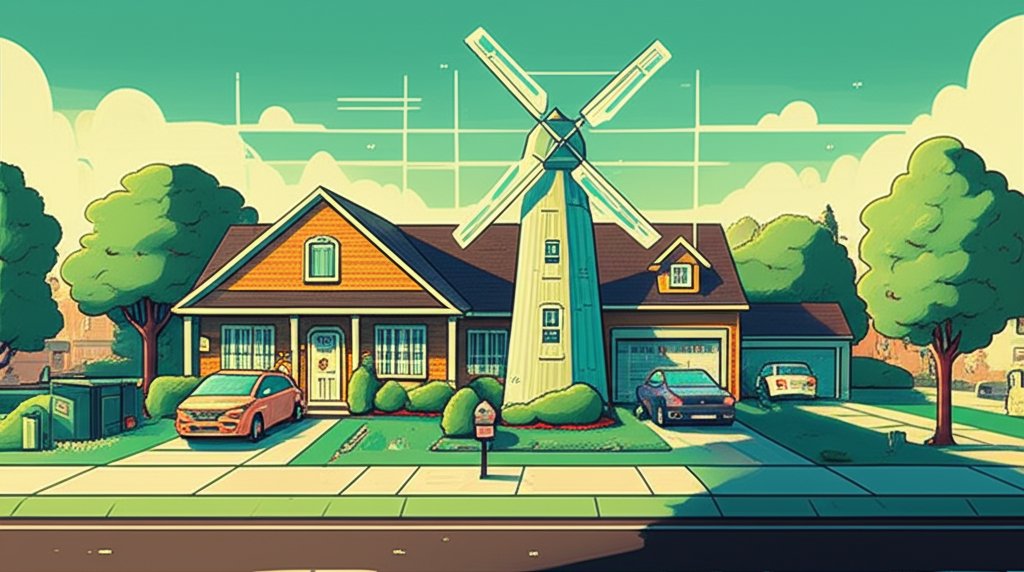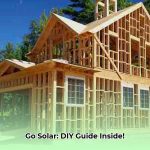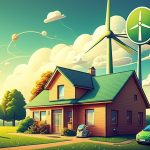Thinking about generating your own power and cutting down on energy bills? A wind turbine generator kit for home might seem like the perfect solution. But before you jump in, it’s crucial to understand what’s involved and whether it truly fits your needs. The reality can be more nuanced than the marketing.
At a glance:
- Understand the different types of wind turbines suitable for home use (horizontal vs. vertical).
- Assess your property’s wind resources to determine if a wind turbine is a viable option.
- Learn the key components of a wind turbine generator kit and how they work together.
- Consider the costs, permits, and installation requirements involved.
- Weigh the pros and cons of DIY installation versus professional help.
- Determine if a home wind turbine will actually save you money, or if other renewable solutions are better.
Horizontal or Vertical: Picking the Right Wind Turbine for Your Home
The first big decision is choosing between horizontal-axis wind turbines (HAWTs) and vertical-axis wind turbines (VAWTs). HAWTs are the traditional propeller-style turbines you see in wind farms. VAWTs, on the other hand, have their blades rotating around a vertical axis. Each has its pros and cons for home use.
- HAWTs (Horizontal Axis Wind Turbines): Generally more efficient at converting wind energy into electricity, especially in areas with consistent wind speeds. They need to be pointed into the wind, which is handled by a tail or yaw mechanism. They are often larger and need to be mounted on a tall tower.
- VAWTs (Vertical Axis Wind Turbines): Can accept wind from any direction without needing to be re-oriented. Can be installed closer to the ground. They are often more aesthetically pleasing to some homeowners and are often quieter. Generally less efficient than HAWTs and may struggle in turbulent wind conditions. Learn more about VAWT design. They also don’t require tall towers making them a bit more practical for some home installations.
Which one is best for you? If you have consistent, strong winds and space for a tall tower, a HAWT might be the better choice from a power generation perspective. If you have more variable winds, limited space, or aesthetic concerns are high on your list, a VAWT could be a better fit. Recent research shows promising improvements in VAWT efficiency through optimized blade design, potentially making them more competitive. For instance, optimizing a blade’s pitch profile can boost efficiency by 200% while simultaneously decreasing vibrations by 77%.
Assessing Your Wind Resource: Is There Enough Wind to Make it Worthwhile?

You wouldn’t plant a cactus in a rainforest. Similarly, installing a wind turbine in an area with minimal wind is a recipe for disappointment. You need to realistically evaluate your property’s wind resource.
- Wind Maps: Check online wind maps for your area. These can give you a general idea of average wind speeds. However, these maps often don’t account for local terrain features like hills, trees, and buildings, which can significantly affect wind flow.
- On-Site Measurement: The most accurate way to assess your wind resource is to use an anemometer to measure wind speeds at your site over a period of at least a year. Some companies offer wind resource assessment services. This is an investment, but it can prevent you from wasting money on a turbine that won’t perform.
- Consider Obstructions: Trees, buildings, and other obstacles can create turbulence and reduce wind speed. Aim to place your turbine in a location that is as exposed as possible to prevailing winds.
Practical Example: John lives in a rural area, but his property is surrounded by tall trees. He initially thought a wind turbine was a great idea. However, after using an anemometer for a few months, he found that the average wind speeds at turbine height were too low and inconsistent to justify the investment. He opted for solar panels instead, which were a better match for his location.
Understanding the Wind Turbine Generator Kit: Key Components
A wind turbine generator kit isn’t just a turbine. It’s a system of components that work together to capture wind energy and convert it into usable electricity. Here’s a breakdown:
- Turbine: Captures the wind’s energy and converts it into rotational energy.
- Generator: Converts the rotational energy into electricity.
- Tower: Elevates the turbine to capture stronger, less turbulent winds.
- Charge Controller: Regulates the electricity produced by the generator to prevent overcharging batteries.
- Batteries (Optional): Store excess electricity for use when the wind isn’t blowing. Crucial for off-grid systems.
- Inverter (Optional): Converts DC electricity from the batteries or generator into AC electricity, which is the standard for most household appliances. Necessary for grid-tied and some off-grid systems.
- Wiring and Hardware: Cables, connectors, and mounting hardware needed to connect all the components.
Important Note: Carefully review the specifications of each component in the kit to ensure that they are compatible and meet your needs. Don’t skimp on quality, especially for the generator and inverter.
Costs, Permits, and Installation: What You Need to Know
Installing a wind turbine generator kit involves significant upfront costs, potential permitting hurdles, and careful installation.
- Costs: Wind turbine generator kits can range in price from a few hundred dollars for small, low-power models to tens of thousands of dollars for larger, more powerful systems. Factor in the cost of the tower, batteries (if needed), inverter (if needed), wiring, and installation. High-quality VAWTs, while initially more expensive, might offer a better long-term investment thanks to lower maintenance and potentially increased lifespan.
- Permits: Check with your local government to see if you need a permit to install a wind turbine. Zoning regulations, height restrictions, and environmental concerns can all impact the permitting process. Be prepared for delays and potential fees.
- Installation: Installing a wind turbine can be a complex and potentially dangerous task. It involves working at heights, dealing with electrical wiring, and handling heavy equipment.
DIY vs. Professional Installation:
| Feature | DIY Installation | Professional Installation |
| —————- | ———————————————————————————————————————————– | ———————————————————————————————————————————————————————————– |
| Cost | Lower upfront cost | Higher upfront cost |
| Expertise | Requires significant technical knowledge and experience | Ensures proper installation and compliance with codes |
| Safety | Higher risk of accidents and injuries | Minimizes safety risks |
| Warranty | May void the warranty if not installed correctly | Typically includes a warranty on the installation |
| Time Commitment | Significant time commitment | Frees up your time |
Recommendation: Unless you have extensive experience with electrical work, mechanical engineering, and construction, it’s generally best to hire a qualified professional to install your wind turbine. The cost is higher, but the peace of mind and safety are worth it.
Will a Home Wind Turbine Actually Save You Money?

The ultimate question: will a home wind turbine actually save you money? The answer depends on a variety of factors, including:
- Wind Resource: As discussed earlier, you need a good wind resource to generate enough electricity to offset the cost of the turbine.
- Electricity Consumption: The more electricity you use, the more you can potentially save with a wind turbine.
- Net Metering Policies: If you’re connected to the grid, check with your local utility to see if they offer net metering. This allows you to sell excess electricity back to the grid, which can help you offset the cost of the turbine.
- Incentives and Rebates: Look for federal, state, and local incentives and rebates that can help reduce the upfront cost of the turbine.
- Maintenance Costs: Wind turbines require maintenance, including periodic inspections, lubrication, and repairs. Factor these costs into your calculations.
Break-Even Analysis: Calculate the payback period for your wind turbine by dividing the total cost of the system by the annual savings on your electricity bill. Consider factors like inflation and the declining cost of alternative energy sources like solar.
Case Snippet: Sarah installed a small wind turbine on her property and connected it to the grid with net metering. While she was initially excited about saving money, she soon realized that the turbine wasn’t generating enough electricity to offset the cost of the system. After a few years, she removed the turbine and installed solar panels, which proved to be a more cost-effective solution for her location and energy needs.
Quick Answers: Common Questions About Home Wind Turbines
- Q: Are wind turbines noisy?
- A: HAWTs can produce some noise, especially at higher wind speeds. VAWTs are generally quieter.
- Q: Do wind turbines kill birds?
- A: Bird collisions are a concern, especially with HAWTs. Proper site selection and turbine design can help minimize this risk. Some studies suggest VAWTs are safer for birds due to their slower rotation and lateral blade movement.
- Q: How long do wind turbines last?
- A: With proper maintenance, a wind turbine can last 20-30 years.
- Q: Can I install a wind turbine in an urban area?
- A: It depends on local regulations and wind conditions. VAWTs are often a better option for urban environments due to their smaller size and quieter operation.
- Q: What size wind turbine do I need?
- A: This depends on your electricity consumption and the available wind resource. Consult with a wind turbine installer to determine the appropriate size for your needs.
Actionable Close: Is a Wind Turbine Right for You? Decision Tree
Before investing in a wind turbine generator kit for home, walk through this decision tree:
- Assess Wind Resource: Is your average wind speed at turbine height at least 10 mph?
- Yes: Proceed to step 2.
- No: A wind turbine is likely not viable. Consider alternative energy sources.
- Evaluate Electricity Consumption: Do you use a significant amount of electricity (e.g., >1000 kWh per month)?
- Yes: Proceed to step 3.
- No: A smaller wind turbine or alternative energy sources may be more appropriate.
- Check Local Regulations: Are wind turbines permitted in your area?
- Yes: Proceed to step 4.
- No: A wind turbine is not an option.
- Calculate Costs and Savings: Can you realistically achieve a payback period of 10 years or less, factoring in all costs and available incentives?
- Yes: A wind turbine may be a good investment. Proceed with further research and planning.
- No: Explore alternative energy sources or energy efficiency measures.
A wind turbine generator kit for home can be a rewarding investment, but it’s crucial to do your homework and make sure it’s the right fit for your needs and location. Don’t get caught up in the hype – conduct a thorough assessment and make an informed decision.
- Wind Turbine Generator Kit For Home: Is One Right For You? - November 2, 2025
- Wind Turbine Fire: Questions About Safety Spark Debate - October 31, 2025
- Vertical Axis Wind Turbine Design: Improving Efficiency and Overcoming Limits - October 29, 2025













